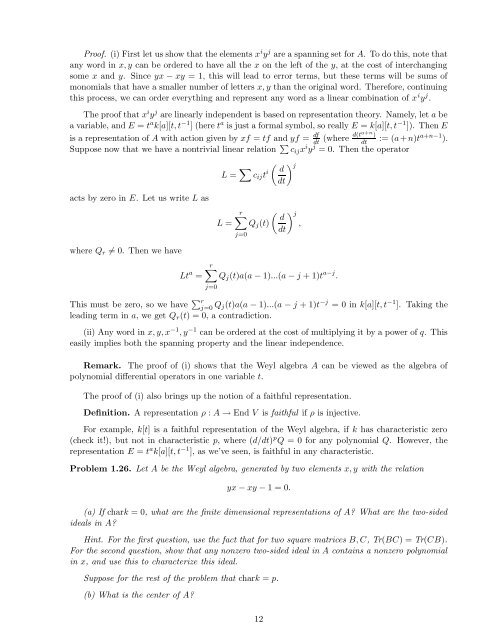Lecture notes for Introduction to Representation Theory
Lecture notes for Introduction to Representation Theory
Lecture notes for Introduction to Representation Theory
You also want an ePaper? Increase the reach of your titles
YUMPU automatically turns print PDFs into web optimized ePapers that Google loves.
Proof. (i) First let us show that the elements x i y j are a spanning set <strong>for</strong> A. To do this, note that<br />
any word in x, y can be ordered <strong>to</strong> have all the x on the left of the y, at the cost of interchanging<br />
some x and y. Since yx − xy = 1, this will lead <strong>to</strong> error terms, but these terms will be sums of<br />
monomials that have a smaller number of letters x, y than the original word. There<strong>for</strong>e, continuing<br />
this process, we can order everything and represent any word as a linear combination of x i y j .<br />
The proof that x i y j are linearly independent is based on representation theory. Namely, let a be<br />
a variable, and E = t a k[a][t, t −1 ] (here t a is just a <strong>for</strong>mal symbol, so really E = k[a][t, t −1 ]). Then E<br />
df d(t a+n )<br />
is a representation of A with action given by xf = tf and yf = dt<br />
(where<br />
dt<br />
:= (a + n)t a+n−1 ).<br />
Suppose now that we have a nontrivial linear relation ⎨ c<br />
i ij x y j = 0. Then the opera<strong>to</strong>r<br />
acts by zero in E. Let us write L as<br />
where Q r ⇒= 0. Then we have<br />
i<br />
L = d j<br />
c ij t<br />
dt<br />
r d j<br />
L = Q j (t) ,<br />
dt<br />
j=0<br />
<br />
r<br />
Lt a = Q j (t)a(a − 1)...(a − j + 1)t a−j .<br />
j=0<br />
This must be zero, so we have ⎨ r<br />
j=0 Q j (t)a(a − 1)...(a − j + 1)t −j = 0 in k[a][t, t −1 ]. Taking the<br />
leading term in a, we get Q r (t) = 0, a contradiction.<br />
(ii) Any word in x, y, x −1 , y −1 can be ordered at the cost of multiplying it by a power of q. This<br />
easily implies both the spanning property and the linear independence.<br />
Remark. The proof of (i) shows that the Weyl algebra A can be viewed as the algebra of<br />
polynomial differential opera<strong>to</strong>rs in one variable t.<br />
The proof of (i) also brings up the notion of a faithful representation.<br />
Definition. A representation δ : A ⊃ End V is faithful if δ is injective.<br />
For example, k[t] is a faithful representation of the Weyl algebra, if k has characteristic zero<br />
(check it!), but not in characteristic p, where (d/dt) p Q = 0 <strong>for</strong> any polynomial Q. However, the<br />
representation E = t a k[a][t, t −1 ], as we’ve seen, is faithful in any characteristic.<br />
Problem 1.26. Let A be the Weyl algebra, generated by two elements x, y with the relation<br />
yx − xy − 1 = 0.<br />
(a) If chark = 0, what are the finite dimensional representations of A? What are the two-sided<br />
ideals in A?<br />
Hint. For the first question, use the fact that <strong>for</strong> two square matrices B, C, Tr(BC) = Tr(CB).<br />
For the second question, show that any nonzero two-sided ideal in A contains a nonzero polynomial<br />
in x, and use this <strong>to</strong> characterize this ideal.<br />
Suppose <strong>for</strong> the rest of the problem that chark = p.<br />
(b) What is the center of A?<br />
12

















